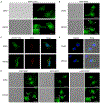A high dose KRP203 induces cytoplasmic vacuoles associated with altered phosphoinositide segregation and endosome expansion
- PMID: 38735134
- PMCID: PMC11416131
- DOI: 10.1016/j.bbrc.2024.149981
A high dose KRP203 induces cytoplasmic vacuoles associated with altered phosphoinositide segregation and endosome expansion
Abstract
In animal cells, vacuoles are absent, but can be induced by diseases and drugs. While phosphoinositides are critical for membrane trafficking, their role in the formation of these vacuoles remains unclear. The immunosuppressive KRP203/Mocravimod, which antagonizes sphingosine-1-phosphate receptors, has been identified as having novel multimodal activity against phosphoinositide kinases. However, the impact of this novel KRP203 activity is unknown. Here, we show that KRP203 disrupts the spatial organization of phosphoinositides and induces extensive vacuolization in tumor cells and immortalized fibroblasts. The KRP203-induced vacuoles are primarily from endosomes, and augmented by inhibition of PIKFYVE and VPS34. Conversely, overexpression of PTEN decreased KRP203-induced vacuole formation. Furthermore, V-ATPase inhibition completely blunted KRP203-induced vacuolization, pointing to a critical requirement of the endosomal maturation process. Importantly, nearly a half of KRP203-induced vacuoles are significantly decorated with PI4P, a phosphoinositide typically enriched at the plasma membrane and Golgi. These results suggest a model that noncanonical spatial reorganization of phosphoinositides by KRP203 alters the endosomal maturation process, leading to vacuolization. Taken together, this study reveals a previously unrecognized bioactivity of KRP203 as a vacuole-inducing agent and its unique mechanism of phosphoinositide modulation, providing a new insight of phosphoinositide regulation into vacuolization-associated diseases and their molecular pathologies.
Keywords: Endosome; KRP203; Mocravimod; Phosphoinositide; RAB; Vacuolization.
Copyright © 2024. Published by Elsevier Inc.
Conflict of interest statement
Declaration of competing interest The authors declare no conflict of interest.
Figures




References
-
- Henics T, Wheatley DN, Cytoplasmic vacuolation, adaptation and cell death: a view on new perspectives and features, Biol. Cell 91 (1999) 485–498. - PubMed
-
- Aki T, Nara A, Uemura K, Cytoplasmic vacuolization during exposure to drugs and other substances, Cell Biol, Toxicology 28 (2012) 125–131. - PubMed
-
- Suzuki C, Takahashi M, Morimoto H, Izawa A, Ise H, Fujishiro J, Murakami T, Ishiyama J, Nakada A, Nakayama J, Shimada K, Ikeda U, Kobayashi E, Efficacy of mycophenolic acid combined with KRP-203, a novel immunomodulator, in a rat heart transplantation model, J. Heart Lung Transplant 25 (2006) 302–309. - PubMed
-
- Song J, Matsuda C, Kai Y, Nishida T, Nakajima K, Mizushima T, Kinoshita M, Yasue T, Sawa Y, Ito T, A novel sphingosine 1-phosphate receptor agonist, 2-amino-2-propanediol hydrochloride (KRP-203), regulates chronic colitis in interleukin-10 gene-deficient mice, J. Pharmacol. Exp. Therapeut 324 (2008) 276–283. - PubMed
Publication types
MeSH terms
Substances
Grants and funding
LinkOut - more resources
Full Text Sources
Research Materials

